Stand-to-pee Toilet: Practical Competency and Gendered Bodily Norms
Stand-to-pee (STP) devices allow females to urinate while standing upright.
Written by Jack Linzhou Xing
Published on 27/12/2020
Stand-to-pee (STP) devices allow females to urinate while standing upright. First applied in medical areas, STP devices were promoted into the market in the 1990s targeting women in traveling, camping, sports, and festivals, or all of whom cannot enjoy satisfactory, convenient or hygiene female toilets.[1] Afterward, there started to appear fixed toilets with STP devices (hereinafter STP toilets). In the recent decade, STP toilets were transferred to China.
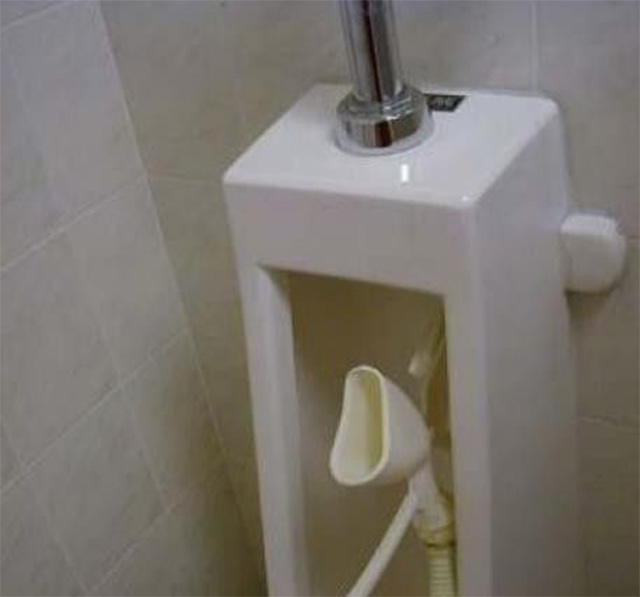
STP devices are claimed to have practical advantages of water-saving, spacesaving, and queue-relieving, and can help women overcome the difficulty of going to the toilet in public spaces, thus enhance their mobility. Despite this significance, it faces difficulty in promotion because of its radical challenge to conventional gendered bodily norms. This difficulty is also true in China. One case of such a project of promotion was in University N in Xi’an, Shaanxi Province in 2010, where the university built STP toilets in several buildings yet failed to popularize them in the later years.
Origin: The Female Toilet Issue
University N focuses on teacher training. Due to China’s education landscape that the teacher job is overly dominated by female practitioners, the student population of University N is overly leaned to female. The majority of the buildings in the old campus were built in the 1960s or 70s, and fitted poorly in the rapid development of the university and the sharp increase in student number. This creates a serious downgrade of students’ life quality. One of the most serious problems for female students is the difficulty of going to the toilets. According to some students, “female students queued as if they were waiting for buses that never come” (former University N student).
The then university leadership seemed to realize this difficulty. Before 2010, they conducted several small-scale toilet expansions. But these efforts were “genderneutral” – every time they expanded the male and female toilets with a similar scale. These efforts seemed to make little difference. In 2010, the university finally launched a female-targeted toilet expansion project, which was the STP toilet promotion.
The STP toilet promotion project in University N was initiated by Professor Q. According to her, her inspiration for the project came from Mrs. Ye Ganlin (叶甘霖) who was arguably the first activist in promoting STP devices in China. Prof. Q also realized the popularity of STP toilets in European countries, where similar facilities are common in public places such as concert halls, festival sites, airports, etc.
Another inspiration, or a similar kind of device, is mobile STP devices, exemplified by GoGirl, an American brand founded in 2009. GoGirl is a mobile STP device made with flexible, germ, and water-resistant Medical Grade Silicone. According to its website, its shape is designed closely according to female body structures, allowing users to cling it with their bodies; its patented splash guard eliminates overflow and leakage problems; and it could be disposable or reused according to users’ preference. Different from STP toilets which are fixed in one spot, GoGirl targets on women going outside without satisfactory, clean, or existing toilet facilities on mobile usage.
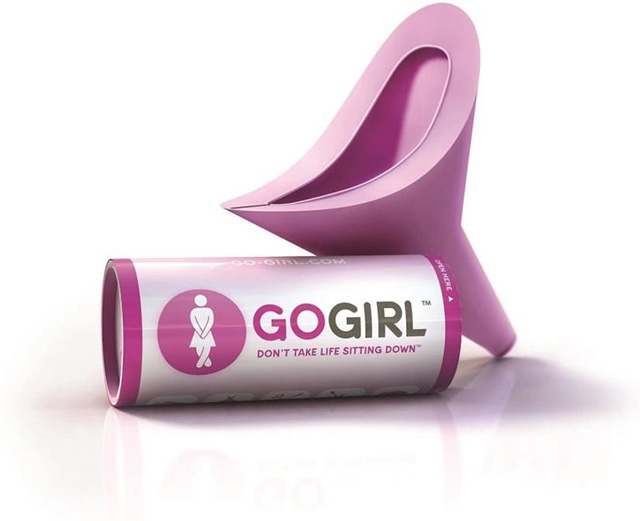
Simple Design and Apathetic Promotion
In Prof. Q’s recall, the leaders of University N were open to the project. In October 2010, several STP toilets each with eight urinals were constructed in various buildings on the old campus. They were rebuilt from some previous common toilets.
Entering the toilet gate, one could see that the toilet was pink. According to university staff, this was to create a “girly” atmosphere to relieve newcomers from embarrassment. On each side of the toilet corridor are three urinal cells. Similar to those of regular female toilets, the cells are separated by the pink separating walls: Those separating the cells and the outside space are at the height of 1.8 to 1.9m, but those between cells are only about 1.5m. The cell size is much smaller than those of regular female toilets, but still occupy more space than the usual urinals in male toilets. One thing noticeable is the cell doors: not like the walls, the doors can only cover a standing body from the middle of one’s lap to the position above her chest. This makes it easy for others to notice whether there are people in the cells. Looking closely, one can notice that when the cell is empty, people could even see the bottom of the urinals.
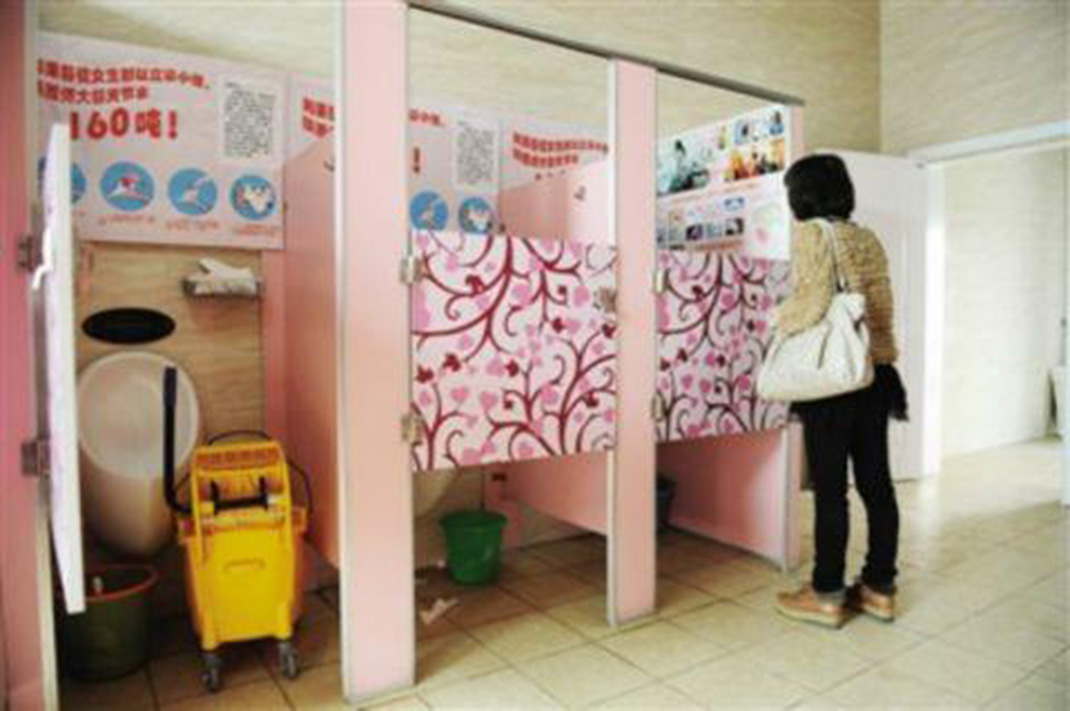
Inside the cells are pictures and posters introducing and promoting the advantage and application of FUD urinals. In every cell, right against the user is a poster saying that if all the female students in University N uses STP urinals, there would be 160 tons of water saved per day, below which is three-step usage guidance with pictures (see Figure 4). Further below the usage guidance and above the wall-fixed urinal is a shelf fixed in the wall containing fluid directors and paper tissues. The decoration of side-walls is different in different cells. In cells at the two ends, since the walls are relatively high, posters are introducing the application and spread of similar devices in other countries.
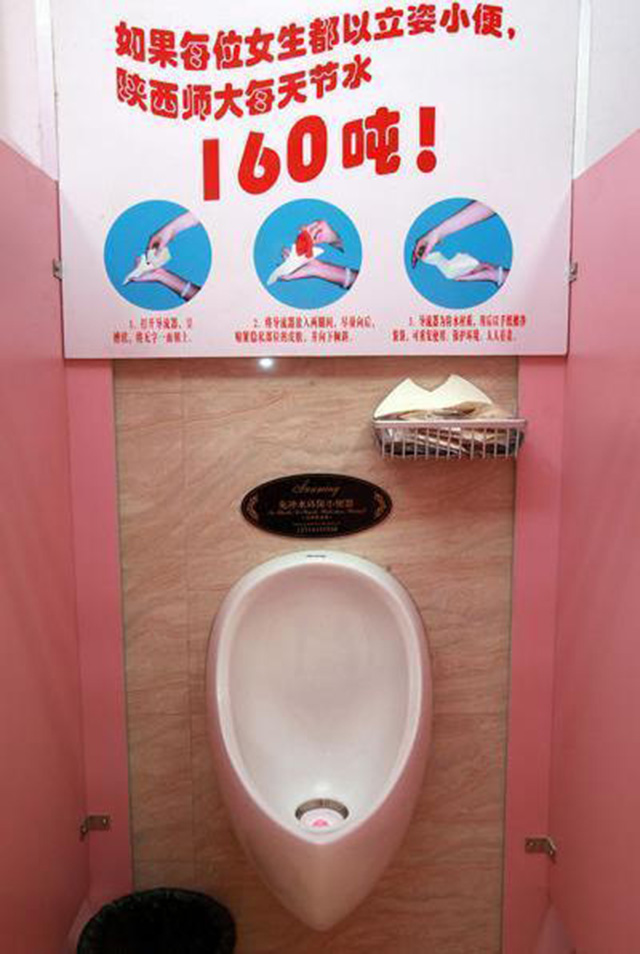
The fluid directors have a similar function to GoGirl. They are made of water resistance papers, and are claimed to be reusable – the guidance suggests students clean the used fluid director with tissues and keep it, so that they reuse it next time or even outside when toilets are not satisfactory. The fluid director was as simple as a square paper folded into the shape of a funnel, with the fold serving as the channel of liquid, without other components fitting the body structure or enhancing the leak proofness.
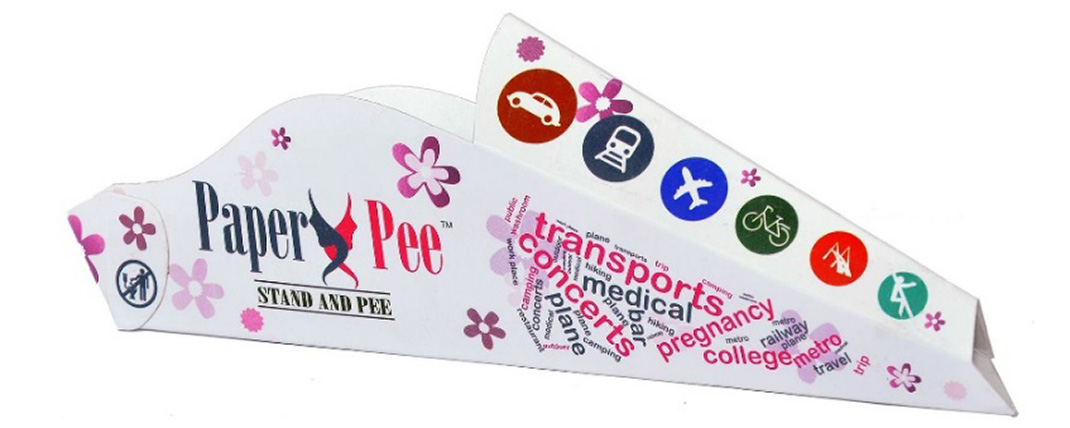
Somewhat surprisingly, according to the enthusiastic building of the STP toilets, the university leadership did not conduct much promotion. When asked about the reason, they referred to outside social pressure which stopped them from constantly engaging in promotion and controversies:
“This received lots of media and online attention, but with lots of students, netizens and journalists criticizing us as ‘corrupting public morality (伤风败俗 shangfeng baisu)’ or ‘blindly scrambling (瞎折腾 xia zheteng)’. This is partly why we slowed down the pace of promotion.”
User Responses: Design, Guidance, and Bodily Norms
The toilets were put in use, yet not popular. Student informants raised several justifications for them being not willing to use them.
The most significant complaints were about the design. Most students said that the fluid directors are difficult to use, especially to hold the fluid director while standing:
“I need to hold the slippery piece of card-paper at its bottom, cling it on my body with my wrist turned upward. The gesture is hard.”
Another problem was about hygiene. Although the instruction said that the fluid director was renewable, students generally worried about the cleanness of the fluid director, and usually deemed them as disposable.
The third problem was about the design of the fluid director: “It’s too open, causing leakage. It’s pretty annoying – we need to wash hands hard. And the water-resistant paper is too hard to hold and very easy to creep down.”
This difficulty in usage has made students feel more awkward when using the toilets, which further drives them away from exploring and using: “The more embarrassing, the harder to use, and vice versa.”
The criticism even extended into the overall decorations, where students reported that they felt shameful when using the toilet in this kind of decoration:
“See how small the door is? It’s awkward to pee while seeing each other. The walls are all pink. This is wired. I understand that they want to make the place girly…but who will paint a toilet pink?”
The second set of complaints were about University N’s lack of promotion and guidance. One sort of complaint was on the focus of water-saving and the lack of other promotion and training:
“All are about saving water. Who cares? It’s standing to pee! One single reason for saving water cannot attract me to this. What about how to use it and get used to it?”
Informants also showed their concerns beyond practical complaints. They generally admitted that “shame” is more important in their concerns of the STP toilets:
“I dare say that the biggest shortcoming of the whole thing isn’t on the facilities, but on ourselves. We’re too shy and find this embarrassing.”
Students mentioned different aspects of “shamefulness”. The first major aspect was the fear of association with the male bodily gesture. Most of them specified that they are shy to act as boys: “It’s like man peeing. Very shameful. That fluid director is like the dingding [丁丁, a popular word referring to the penis]. It’s embarrassing to ‘pretend’ to be a boy.”
The second aspect lied on the unfamiliarity of their bodies or the unaccustomedness of the touch by outside objects. Students complained that they felt uncomfortable with using the fluid director, which involves touching and adjusting their bodies by hand and by the fluid director: “I hate to hand my ‘that area’. Sometimes you cannot adjust to a proper position, so you keep tipping and tipping that area. Too embarrassing and disgusting.” It is obvious that the design and lack of training made the operation more difficult and more shameful.
Failure and Takeaway: Practical Design and Social Norms
The project ended up a de facto failure. Since 2014, the STP toilets, under a very low usage rate, were gradually abandoned, with cleaners unofficially using them as storerooms for cleaning tools.
The failure involved both material and social factors. From the material perspective, the technology needs to achieve practical competency by design. From the social perspective, it needs to either get support from relevant social groups to break the existing norms.
Practical competency involves affordance and convenience, i.e., the possibility for users to smoothly use the technology. In the case of STP toilets, affordance and convenience means the easiness for users to find the way to hold the fluid director, put it in the right position, make the appropriate bodily gesture and use the whole device, as well as whether they need to worry about problems such as leakage and necessary afterward cleaning. Practical competency also needs to highlight “advantages,” i.e., the benefits technology could bring or achieve. In the case of STP toilets, these include water-saving, space-saving, and queue-relieving.
The failure to achieve affordance and convenience is largely due to the design process. In the case of STP toilets, the initial decision of changing existing toilets into STP toilets has already shown the designers’ carelessness of female user experiences. Other major designs, including the paper-made fluid directors, the too low separate walls, and the doors covering too few spaces, all made the product difficult and embarrassing to use. On the other hand, the achievement of advantages such as water-saving and space-saving is not clear at all. Most students did not think water-saving is closely relevant to them. For space-saving and queue-relieving, since the number of such toilets are still limited, such advantages are hard to show.
At the social level, as a technology that aggressively challenges the existing gendered practice, experience, habit, and understanding of urination, STP devices are bound to face resistance by social norms. Toilet, as an in-principle genderneutral technology, is actually one of the most gender-exclusive spaces in modern life. Based on such features, popular gendered bodily norms play a very strong role in people’s, especially women’s experience related to toilets.
The first aspect of such norms lies in the fear of women presenting themselves in the public and getting recognized. In the case of STP toilets, all people involved showed their anxiety, fear, or criticisms of “going to that toilet,” “peeing with that shameful gesture,” “throwing and showing faces” in new toilets, and “corrupting public morality”. These reflected the potential risk of women enjoying the mobility of freely choosing the place and body position of going to the toilet. As Davis argues in his book on Los Angeles, the number of female toilets directly indicates the mobility of women in the city.[2] When the new toilets are installed, both the users and the public did not feel a relief of the partial solution of female student home-making, but instead started to fear and be anxious about how this free choice of how and where to go to the toilet by women could cause harm.
The second perspective is the fear of women challenging the male embodiment, or the anxiety of blurring the difference of embodiment between female and male. In the case of STP toilets, many students said that they easily associate their bodily gestures with “men”, “dingding”, etc., and were anxious about that. Halford et al. emphasizes that the “public realm”, designed by people with male body experiences, is dominated by the rules set according to male behaviors.[3] Similarly, in their attitude towards STP toilets, both users themselves and the netizens are anxious in blurring the boundary between male and female in terms of the peeing gesture, messing up with the users’ gender identity, imitating or triggering the association of men.
The third aspect is women’s unfamiliarity with their bodies and the corresponding unaccustomedness of the touch from outside objects. The female students are not used to the STP toilets not only because of shamefulness but also due to their incompetency to find the right place and position. Different from men who are usually open in treating and presenting their bodily image, body-hatred is a common phenomenon among women. According to Hsu & Cheng, many Taiwanese women failed to get used to tampons because of the unfamiliarity of their body structure, and the process of learning to use tampons is also a process of gaining knowledge of their own bodies.[4]
Faced with such strong resistance from gendered bodily norms, technologies that are under promotion usually depend on whether relevant social groups can support them. There are two powerful relevant social groups in the case of the STP toilet project, female student and the university leadership. Unfortunately, the project failed to get support from either.
The toilets are evidently not supported by students, who complained about the lack of affordance and convenience and reported anxiety and shamefulness on using them. Moreover, irrelevant and insufficient education, training, and promotion have further enhanced this tendency. To have good output, the promotion should focus on the affordance, convenience, and advantages closely relevant to users. Moreover, more training and education could help users be more comfortable. But University N failed to do so.
As for the support from the university leadership, due to the outside social pressure and fear of controversies, the leadership failed to provide constant support either on new toilet construction or education and training. Actually, one of the reasons why students did not support the technology is exactly the lack of support by the leadership on promotion, training, and education.
Footnotes
- Xiong, Fengtai. 2000. “Nvxing zhuanyong niaodou, xiaoshou huobao qianjing hao (Female stand-to-pee devices: heated sales and great prospective).” Xiandai Yingxiao (Modern Marketing) (11), 14.
- Davis, Mike. 2006. City of Quartz: Excavating the Future in Los Angeles (New Edition). New York: Verso Books.
- Halford, Susan, Mike Savage, and Anne Witz. 1997. “(Re)presentations of ‘home’and ‘work’ in organisational life.” In Gender, Careers and Organisations, pp. 191-227. New York: Palgrave.
- Hsu Pei-hsin, and Ling-fang Cheng. 2010. “Why tampons are not welcomed in Taiwan: A social-worlds analysis.” Technology, Medicine, and Society (10): 11- 64.
